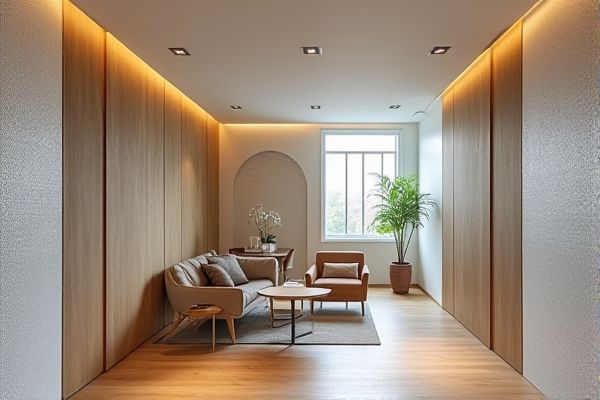
Perforated panels offer superior ventilation, sound absorption, and aesthetic versatility compared to solid panels, which provide maximum privacy, insulation, and structural strength. Discover how choosing between these panel types can enhance your space by reading the full article.
Table of Comparison
| Feature | Perforated Panels | Solid Panels |
|---|---|---|
| Material | Metal, wood, plastic with holes | Metal, wood, plastic with no holes |
| Ventilation | High airflow and breathability | Minimal to no airflow |
| Acoustic Performance | Sound absorption, reduces noise | Sound blocking, reflects noise |
| Privacy | Reduced privacy due to perforations | Complete privacy and coverage |
| Weight | Lighter due to holes | Heavier, solid material |
| Aesthetic | Modern, decorative, customizable patterns | Clean, uniform, classic look |
| Durability | Durable but may weaken due to holes | Highly durable and sturdy |
| Applications | Acoustic panels, ventilation grilles, decorative facades | Wall cladding, privacy screens, structural panels |
| Cost | Typically higher due to manufacturing complexity | Generally lower and simpler to produce |
Introduction to Perforated and Solid Panels
Perforated panels feature a series of holes or patterns that offer ventilation, sound absorption, and aesthetic appeal, making them ideal for architectural and acoustic applications. Solid panels provide robust structural support, superior privacy, and complete coverage, commonly used in walls, partitions, and cabinetry. Choosing between perforated and solid panels depends on your needs for airflow, light transmission, and durability in a given space.
Material Composition and Design Differences
Perforated panels are typically made from metals like aluminum or steel, featuring a series of holes or patterns that reduce material weight and allow airflow, contrasting with solid panels made from dense materials such as wood, metal, or composite without openings. The design of perforated panels enhances acoustic performance and ventilation while maintaining structural integrity, whereas solid panels offer superior insulation and complete privacy due to their uninterrupted material surface. Material composition in perforated panels prioritizes corrosion resistance and durability, often treated with coatings to withstand environmental exposure, while solid panels focus on strength and thermal properties depending on the specific material used.
Aesthetic Appeal: Visual Impact of Each Panel Type
Perforated panels offer a dynamic aesthetic appeal with patterns that create depth, texture, and light play, enhancing architectural interest. Solid panels provide a sleek, uniform surface that emphasizes clean lines and a minimalist visual impact, ideal for modern designs. Your choice depends on whether you want a bold statement with perforations or a smooth, uninterrupted look with solid panels.
Acoustic Performance: Sound Management Capabilities
Perforated panels enhance acoustic performance by absorbing and diffusing sound waves, reducing reverberation and controlling noise levels more effectively than solid panels. Solid panels primarily reflect sound, which can cause echoes and increased noise within a space. You can improve your room's sound management by choosing perforated panels designed with optimized hole patterns and backing materials for superior sound absorption.
Thermal Properties: Insulation and Energy Efficiency
Perforated panels enhance thermal properties by allowing air circulation, which reduces heat buildup and improves ventilation, contributing to better insulation and energy efficiency. Solid panels provide more consistent thermal insulation by blocking airflow and retaining heat, making them suitable for maximizing energy conservation in temperature-controlled environments. Selecting between perforated and solid panels depends on balancing ventilation needs against insulation requirements for optimal energy performance.
Ventilation and Airflow: Functional Advantages
Perforated panels offer superior ventilation and airflow compared to solid panels, allowing air to pass freely while maintaining structural integrity. This enhanced airflow helps regulate temperature and reduce moisture buildup, making them ideal for applications requiring breathability and cooling. Your choice of perforated panels can improve indoor air quality and energy efficiency by facilitating natural ventilation.
Durability and Maintenance Requirements
Perforated panels typically offer enhanced ventilation, but may be more susceptible to debris accumulation and corrosion, requiring regular cleaning and inspection to maintain durability. Solid panels provide superior resistance to weather elements and physical impact, resulting in lower maintenance needs and longer service life. Choosing between the two depends on the specific environmental conditions and maintenance capabilities of the installation site.
Cost Comparison: Initial Investment and Lifecycle Expenses
Perforated panels typically have a lower initial investment due to reduced material usage but may incur higher lifecycle expenses from maintenance and potential durability issues compared to solid panels. Solid panels, while more expensive upfront, offer greater longevity and less maintenance, potentially resulting in lower total lifecycle costs. Evaluating your project's budget requires balancing initial savings with long-term expense projections to determine the most cost-effective panel choice.
Application Areas: Best Use Cases for Each Panel Type
Perforated panels excel in applications requiring ventilation, sound absorption, and partial visibility, making them ideal for architectural facades, acoustic treatments, and industrial screening. Solid panels provide superior privacy, thermal insulation, and structural strength, best suited for security barriers, interior walls, and exterior cladding where weather resistance is critical. Your choice depends on whether airflow and light diffusion or complete coverage and durability are prioritized in the project.
Choosing the Right Panel: Key Decision Factors
Choosing the right panel depends on your specific needs for ventilation, sound absorption, and aesthetic appeal. Perforated panels offer enhanced airflow and acoustic benefits, making them ideal for spaces requiring noise control and air circulation. Solid panels provide superior privacy, durability, and a sleek, uniform appearance, fitting well in settings where soundproofing and visual separation are priorities.
 homyna.com
homyna.com